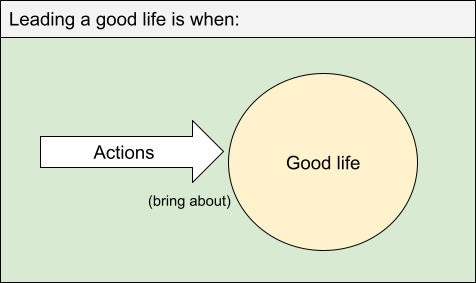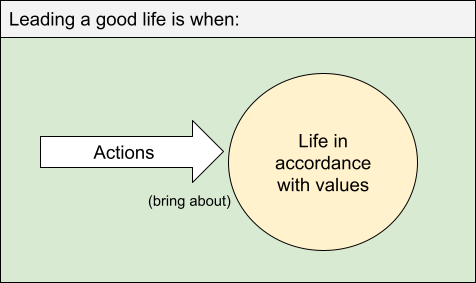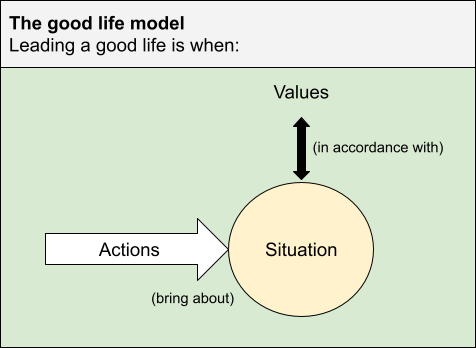What Does It Mean To Lead A Good Life?
“What does it mean to lead a good life?” This is a question that humanity has thought about for thousands of years and there is yet no agreed upon answer. Some believe leading a good life is doing that which gives most pleasure and least pain. Others believe that it is to live according to some set of principles, like always being honest, regardless of what the consequences turn out to be by doing so. Some believe leading a good life means you follow the word of a certain religion or religious leader. Others believe that leading a good life is being the most productive and having the most impact on the world. And so on. Clearly, if there is a way to give a final answer to what it means to lead a good life it isn’t easy. But if A Wiser World is to succeed in its mission to help people lead a good life then this is a question that needs to be answered to at least some degree. So let’s see what progress we can make.
Starting from the fundamentals
Since we are trying to establish what wisdom is from first principles, let’s start by trying to identify the core of what it means to live a life, to be alive. If we think about it we will find that living life is about doing things. An object that does nothing at all, doesn’t move, doesn’t interact with the environment, etc, is a lifeless object. So behavior is a central feature in what it means to live. But there are different types of behavior. Some behaviors are just automatic reflexes or instincts, think of the knee-jerk reaction when the doctor tests your reflexes. Such behavior is not really something we can control, and it is not performed in order to achieve something. We don’t weigh pros and cons and decide that “you know what, I think I will jerk my knee”. Behavior where we do have control, and may make conscious decisions on whether to do it or not, are called actions. So, for example, when we pick up a book and start reading it, such a behavior involves some kind of judgement that doing so is a good idea, it is not just a reflex that just happens outside our control. So this kind of behavior is an action.
Given this distinction we can see that actions are central to the question of leading a good life. What we are interested in is making our lives good. This cannot consist of just some reflex behaviors. The whole idea of leading a good life is to consciously shape our lives to be good. So a first step in understanding what it means to lead a good life is to say that it involves performing actions that make life good.
We can illustrate this in the form of a simple model:

Figure 1 – Leading a good life step 1
We can analyze this further. As stated above, people have very different ideas of what it means for a life to be good, but we don’t need to solve this disagreement quite yet. Whatever people believe is a good life, they will all agree that a good life is a life that is in accordance with whatever values they hold. For one person, the values may be “living in accordance with my religion”. For another it may be “doing what brings about the best consequences in the world”. For a third it may just be “being happy”. At this point, it doesn’t matter which those values are, or even whether a person has any clear sense of their values at all. It could turn out that there is a correct set of values that are objectively true for all people, or it could turn out that it is all relative. It still holds true that a good life is a life in accordance to whatever the values are.
We can thus expand on the model as follows:

Figure 2 – Leading a good life step 2
Leading a good life consists of doing quite a lot of things. We perform many actions every day, over many days, weeks, months, and years. If we zoom in on just one action, then this action is part of leading a good life, but it is not an accurate description to say that the one action brings about a good life. Instead we may say that one action may bring about a situation that may be a part of the good life if it is in accordance with the values.
Thus, we can reformulate the last model as follows:

Figure 3 – The good life model
At this stage, what is meant by “situation” can be very broad. If the person values consequences, then the “situation” that is brought about by the action is the collection of consequences that followed the action. But for a person who values living according to certain principles regardless of the consequences, the “situation” can in this context represent a situation where the person has just performed an action that is in line with the specific principles that are valued. So the term “situation” is meant in a very broad sense in this model. We may define “situation” as everything that is the case when the action has been performed. The values will pick out the things out of this “everything” that is relevant in the specific case.
All in all, this model now says: Leading a good life is when the actions we perform bring about situations that are in accordance with our values. We can call this model “The good life model”. It will serve as a first principles framework with which we can further explore what it means for life to be good and how to achieve the good life. It also allows us to create a first principles framework of wisdom.
Next: A First Principles Framework of Wisdom
Page-ID: 17
This page is version 1.0. It has not yet been reviewed by the global community. Do you want to help improve it? Please leave a comment in the google document for this page, or join the email group to be part of the discussion. You can always share your thoughts via email directly to mail@awiserworld.net. Read more about how you can support A Wiser World.